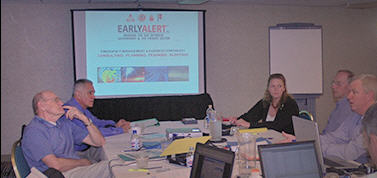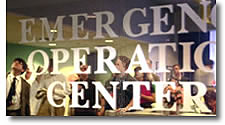Emergency Management and Disaster Coordination
Comprehensive Emergency Management Training
Our training provides in-depth knowledge of Comprehensive Emergency Management (CEM) and the Integrated emergency Management System (IEMS). Included is an in-depth look at the four phases of comprehensive emergency management; mitigation, preparedness, response, and recovery.
The concept used for handling all types of disasters and their consequences is called "comprehensive emergency management" (CEM). CEM was institutionalized with the creation of the Federal Emergency Management Agency (FEMA) in 1979. FEMA emerged from the consolidation of five federal agencies, each dealing separately with an aspect of large-scale emergencies.
Since that time many state, local, and tribal governments have accepted CEM and changed the names of their organizations to include the words "emergency management." More importantly, the name change reflects a switch in orientation from preparedness for single hazards or narrowly defined categories of hazards toward an all-hazards approach-attack, natural, and man-made-to potential threats to life and property. As Congress and FEMA have been quick to point out, this change reflects not a reduction in security, but an increased emphasis on making the nation's emergency management capability responsive to any and all major emergencies, including national security threats.
This expansion into new hazard areas was not the only change the introduction of the concept "comprehensive emergency management" brought about. Three other closely related concepts came out of this transformation. Let's briefly review each one. The first was the all-hazards approach.
We provide a combination of classroom lectures, discussions, small-group planning sessions, and functional exercises which expose participants to new ideas, and increase their awareness of the necessary coordination among other agencies and organizations. For the exercises, each participant is assigned a role similar to their real-life position in an emergency operations center (EOC).
Emergency Management and Disaster Coordination
All communities are vulnerable to a variety of hazards. Emergency management provides a structu
re for anticipating and dealing with emergency incidents. Emergency management involves participants at all governmental levels and in the private sector. Activities are geared according to phases before, during, and after emergency events. The effectiveness of emergency management rests on a network of relationships among partners in the system. This course examines specific parts of the emergency manager's job within the four phases of emergency management: mitigation, preparedness, response, and recovery.
The goal of this course is to introduce you to the fundamentals of emergency management as an integrated system, surveying how the resources and capabilities of all functions at all levels can be networked together in all phases for all hazards including coordinating plans of the various components of the emergency management system fire and police, emergency medical services, public works, volunteers, and other groups contributing to the community's management of emergencies.
Integrated Emergency Management Course (IEMC) - All Hazards: Preparedness and Response
Recent disasters illustrate the need to have disaster preparedness and response plans to provide continuity for a successful recovery. This addresses preparedness and response in emergency situations resulting from man-made and natural disasters. This exercise-based course is designed for both public and private industry. The IEMC places public officials and other key community leaders in a disaster simulation. The course consists of classroom instruction and planning sessions, and exercises allow for structured decision-making in a learning environment that will simulate realistic events.
The course is designed to help you identify and build response and recovery teams. The course focuses on the roles and responsibilities of each team member, and provides guidance on developing a local disaster recovery plan. Best practices in disaster preparedness and response are discussed.
Key emergency management components covered are:
- Defining Disasters and Emergencies
- Emergency Operations Center "101"
- Emergency Support Functions (ESFs)
- Resource Management
- Incident and Disaster Management
- What is Emergency Management
- EOC/ICS interface
- Risk and Damage Assessment
- Short and Long Term Recovery

MODULAR EXPANSION The course objective is to identify additional planning needs providing the opportunity to enhance overall preparedness and response.
- Introduction to Hurricane Preparedness
This course will cover the meteorology, forecasting and hazards associated with hurricanes. Specialist cover preparation activities and liaison coordination among federal, state and local efforts. Regional, state and local operational concepts and practices will be introduced. Participants will have their, "How do I prepare for and protect from a hurricane?" question answered. - Disaster Recovery Planning
This course focuses on the roles and responsibilities of federal, state, tribal, and local efforts to provide guidance to develop a local disaster recovery plan. Best practices in disaster recovery and successful operational experiences are summarized for participants. - Hazardous Weather and Flood Preparedness
This course helps promote a more proactive response to weather and flooding hazards through close coordination between federal, state and local resources. This course includes; how the basic elements of weather can combine to create potential hazards, weather forecast products and how to interpret them, and anticipating hazardous weather for planning, warning and response purposes. - Emergency Operations Center (EOC) Management and Operations
This course provides participants with the knowledge and skills to effectively manage and operate an EOC during crisis situations. The course includes locating and designing an EOC, how to staff, train, and brief EOC personnel, and how to operate and EOC during various situations. - Managing Public Transportation Emergencies
This course will address the existing regulations, procedures for developing and implementing policies, and a review of lessons learned from recent emergency transportation emergencies. After course completions, participants will be able to conduct a Vulnerability Self Assessment of the mass transit infrastructure, determine safety versus security challenges of closing a public transit system, and identify critical emergency response actions and ensure system-wide compliance.



